Swine Nutritionists Challenged to Find Alternatives to Pricey Protein
Pricey protein can wreak havoc on nursery feed budgets and challenge producers and swine nutritionists to find options that won’t throw pigs off feed or break the bank
August 17, 2010

Pricey protein can wreak havoc on nursery feed budgets and challenge producers and swine nutritionists to find options that won’t throw pigs off feed or break the bank. Kansas State University (KSU) swine nutritionist Mike Tokach suggests four options:
1. Lower lysine levels in the first or second diet after weaning. The main goal is to reduce the need for high-quality protein sources by simply not feeding as much excess lysine, Tokach explains. “We know feed per gain will increase slightly, but it is a cost-effective strategy if lysine levels were really high in the pelleted diets fed before 15 to 20 lb. Some have lowered levels to 1.35% standardized ileal digestible lysine,” he adds. Genetics also plays a role in how low lysine levels can go.
2. Replace fish meal with sources already in the diet. Options include blood meal, whey protein, egg protein and DPS-50 (Dried Protein Digest from Pro-Ag). Unfortunately, these have also increased in price. DPS-50 is a dried porcine solubles product increasingly common in nursery diets.
3. Replace fish meal with a new protein source and/or synthetic amino acids, such as peptide-based products like PEP 2+ and PEP-NS (non-soy protein) from TechMix, Inc. The products are derived from porcine mucosa collected in packing plants. Lining of the small intestines provides a protein product similar to DPS, but lower in ash content.
Denny McKilligan, TechMix product development manager, says PEP 2+ contains hydrolyzed soy product and amino acids that can be added at a high inclusion rate in nursery rations.
The newer PEP-NS, which contains no soy but provides higher amino acids relative to price, is another option.
Bob Goodband, KSU swine Extension nutritionist, did much of the research on the peptide-based products. Response was positive, particularly in phase two diets when more of the fish meal was replaced, up to 6%, he says. He is currently testing even higher levels.
“Based on performance and price, peptide products are a very economical alternative to fish meal,” Goodband says.
Synthetic amino acids are always part of the mix, too. Levels are increasing, but there are limitations. “High levels can be added as long as we watch ratios of other amino acids relative to lysine,” Tokach says.
Lysine, threonine and methionine are the top three essential amino acids. Add too much and the non-essential amino acids become a limiting factor.
“We’re running higher levels than we did in the past, but we are limiting the top three based on other amino acids. Valine, tryptophan and isoleucine become critical and then we start worrying about arginine and others,” Tokach notes.
4. Replace fish meal with protein sources considered to be of lower quality. These proteins include sources like distiller’s dried grains with solubles (DDGS), meat and bone meal (MBM), corn gluten meal and poultry meal. It is important to know the source and quality. Performance may suffer, however, which is why this option has found limited favor, Tokach explains.
“Some production systems and feed companies are using DDGS in early nursery diets with other protein sources,” Tokach says. “The main goal is to bring in amino acid sources that allow us to keep soybean (meal) levels low. But you have to be careful. Variable quality will dramatically reduce performance and make it difficult to get pigs on feed. You don’t want to use high levels of any of these sources; however, the amino acid profile complements well with other sources already in the diet and allows use of high levels of synthetic amino acids.”
KSU Extension swine specialist Joel DeRouchey agrees. “We don’t have a lot of experience yet with proteins like MBM in nursery diets, but we’re starting to edge that way. We still want appetite stimulation. Vegetable products just don’t have the same effect on feed intake we see in animal products,” he says.
A lack of confidence in quality has always been the reason certain proteins are avoided for pigs up to 25 lb. “Now cost and availability have pushed us to increase the risk of using some of these other alternatives,” DeRouchey adds.
Oil Spill Drove Prices Higher
The British Petroleum oil spill in the Gulf is the main reason fish meal prices got crazy, according to Tokach. “It went from being a reasonable ingredient for nursery diets to being too expensive for people to consider using anymore.”
Much of the Select Menhaden fish meal is made by Omega Proteins in Louisiana. The product has always been considered an excellent protein source for its amino acid levels and palatability, plus data shows a benefit to immune response from fatty acids in the fish oil.
It should be noted that other feed companies are developing alternative products for fish meal, too.
“Timing has worked to our advantage that fish meal is at these prices,” says Brent Ratliff, TechMix swine nutritionist. “But at the end of the day, we’re confident we have a full-replacement product that improves performance, as well as being cost effective. The longevity of the fish meal market has always been in question. I think the Gulf crisis expedited the process.”
Debra Neutkens is a freelance writer from White Bear Lake, MN.
You May Also Like


